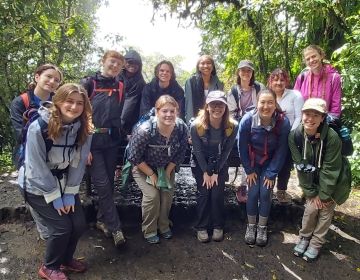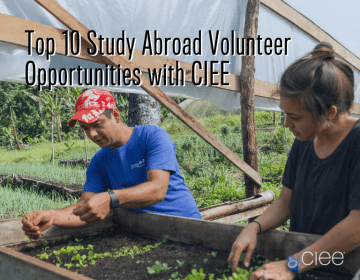Heritage Crops and Garden, by Sasha Lopez (Intern, CIEE Program in Sustainability and the Environment)
For the past three weeks, I’ve spent countless hours researching, planning and constructing a heritage garden at the CIEE Center of Sustainability in Monteverde, Costa Rica. The garden will serve many functions including providing food for the students and staff, offering a beautiful space for relaxing and working, and demonstrating how to build and maintain a heritage garden in Costa Rica. The garden will be available to the residents of the study center as well as the rest of the community. Through the expansion of the garden crops and the educational signs/manual, people can to visit the garden and learn about the history of heritage plants in Costa Rica.
A: The heritage garden with the new planter beds, structures, and signs. B: Tomato and arracache planter bed.Throughout this project, I learned about the history of agriculture in Monteverde. In the 20th century, settlers inhabited this land and cleared some forests for small-scale agriculture and beef cattle. However, over the past decades, the influx of tourism in the area forced people to give up their farms and change jobs to better address the tourist market. As a result, farming practices weakened and many traditional crops started to disappear. The new generations are not as involved in the farming life style, and other jobs and life styles have taken over.
I was very interested finding ways to our bridge the connection between the land and food consumption by creating a demonstrative heritage garden. I am very passionate about food, (especially cooking) and I think one of the most important aspects of food consumption is the knowledge of where the food comes from. Before coming to Costa Rica, I knew very little about food production and diets here. Through my internship I have learned about traditional diets in the region based on these heritage crops. I learned how to indentify, plant, harvest and care for them.
Signs constructed out of bamboo (both the posts and the nails).My greatest accomplishments have been expanding the crop selection (and increasing food production), and renovating the barbacoa (trellis) structure. For the barbacoa, I filled in parts of the structure using bamboo and wire, to help the chayote and passiflora plants to climb up the structure. Heritage gardens often grow wild and untamed. There are usually fruits and vines draping over structures, making it feel like you’re in the jungle. I wanted to replicate that feeling when you enter the heritage garden through the barbacoa structure. I believe that a beautiful entrance to garden is a crucial part of the experience and I want people to truly feel like they’ve entered a new space.
A: This is the barbacoa structure. I filled in the sides with more pieces of bamboo and attached wire from the red fence to the new structure. This will allow the chayote and passiflora plants to climb across the barbacoa. B: The chayote has already caught on to the wire and is on its way to the barbacoa structure.
Related Posts
Costa Rica vs. Argentina: Which is Better for Study Abroad?
Imagine yourself sipping mate in a bustling Buenos Aires café or lounging peacefully in a hammock overlooking Costa Rica's lush rainforests. These contrasting scenes represent just a glimpse of the... keep reading
Happy Earth Day: Today and Every Day
Happy Earth Day! Every April 22, this global event comes around to remind us how precious our planet is, what sustainable efforts we can make to protect Earth, and that... keep reading
Top 10 Study Abroad Volunteer Opportunities with CIEE
Have you ever wondered if you could volunteer abroad? Perhaps you're looking into study abroad programs that provide international volunteer opportunities. If you’re itching to study abroad and truly make... keep reading



